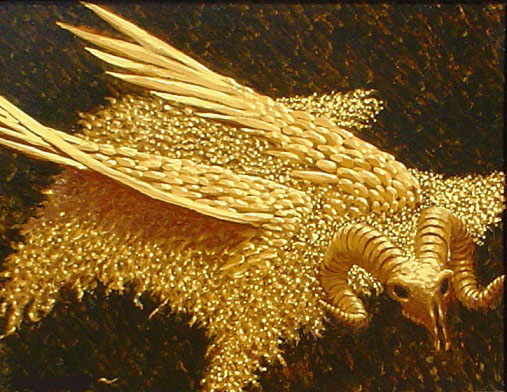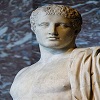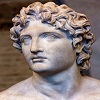Chrysomallus (Golden Fleece)
The magnificent flying golden ram
Almost everyone has heard the fantastic and utterly epic tale of the Golden Fleece, wherein Jason (the heir to the throne of Iolcus) and his Avenger-like team of awesome heroes, heroines, musicians, magicians and demigods sail off in their killer boat, the Argo, in search of a golden fleece with magical powers. In other words, the skin of a ram that had real live (well, dead) golden hair, as well as the far-out power of healing anyone who got wrapped up with it.
Held by the rather villainous King Aetes of Colchis, Jason and his band of adventurers had to hook with his witchy daughter, Medea, fight off flame-belching bulls and go head-to-head with Spartoi, undead soldiers who rose up out of the ground and commanded by the king to wipe the heroes out, to even get to the Fleece…and even then, they had to deal with the beastly drakon that guarded the Fleece in a sacred grove dedicated to Ares, god of war.
In the end, Jason triumphs, snatching the Fleece, getting the girl and escaping the clutches of Aetes to sail back to Iolcus, kick the snot out of his evil uncle and gain the throne… or sort of.
In any case, it’s an epic story that remains one of the highlights of Greek mythology. However, few people ask the question: what exactly IS the Golden Fleece? Where did it come from? How did it come to be hanging in a tree in a forest grove, protected by a giant snake-like drakon? Well, the Fleece DOES have a background story! See, it wasn’t ALWAYS dead and magical…at least not in the context of how it was used in the story.
The Fleece once belonged to a very alive and completely radical creature named CHRYSOMALLUS, a golden ram who sported a set of slick, graceful wings, allowing it to fly hither and yon all over the Aegean Sea! How it actually GOT to Colchis is another interesting tale…
To unravel the backstory of Chrysomallus, you need to back-track to another tale, one that involved Zeus, the king of gods, his wife Hera, and a very naughty king named Ixion, who had a plan to seduce Hera into a corner for a little afternoon make-out session…in Zeus’ own digs at Olympus!
Hera caught wind of the rather sleazy Ixion’s plans, told Zeus (who naturally got rather ticked off), and convinced her husband to act, which he of course did. Taking a bit of cloud, Zeus fashioned a “fake” Hera that looked every bit as real as the original out of it, and created cloud-nymph he named Nephele, which he planned to use as a decoy to trap the dishonest king. Ixion wound up having a romantic interlude with Nephele, thinking the cloud-nymph was Hera.
Zeus caught him in the act and had him sent to Tartarus for an eternity of torture…but that left poor Nephele, who had only been created to be used as a tool, pregnant with Ixion’s gits. Sure enough, in a supernatural birth fit for the weirdness of Greek mythology, she later gave birth to the first centaurs, the half-man, half-horse warriors that inhabit many other stories!
That was bad enough for the sad Nephele, but it was about to get even more tragic. Just when things were looking up after Zeus had let her loose on the earth to find her destiny, she married a swarthy king by the name of Athamas, who got her pregnant AGAIN and then promptly left her for some saucy tart named Ino.
Poor rainy-day-cloudy Nephele just couldn’t catch a whiff of good luck, though she did give birth to twins, Phrixus (the son)and Helle (the daughter), who were really quite good kids, as ancient Greek kids went! Problem: Ino, their stepmother, the snotty younger nasty that Athamas had married, wanted the kids dead. She didn’t want any reminders that her new hubby had had anything to do with Nephele.
Worse yet, she decided to offer them up as a sacrifice to the gods, and had hatched a devilish plot to make it happen so that her hands were clean. Ino secretly roasted all the town's crop seeds so they would never grow (how no one noticed this going on is a mystery, but in the end, it didn’t matter; the seeds were worthless).
The town’s farmers, terrified of the famine and starvation they knew would come because of this, went over to the nearby oracle (speaker-for-the-gods) and asked what they should do to solve the problem. Dastardly Ino was one step ahead of them, as she had bribed the men sent to the oracle to go, come back, and lie about what they had heard. For a hefty reward, she had them tell the rest of the townsfolk that tell the others that in order for the town to survive, the oracle (and the gods!) required the sacrifice of poor Phrixus and Helle.
Nephele, despite her woes, short-comings and bad luck, was a dang good mom and prayed to the gods for assistance in the matter. Zeus must have felt guilty about the whole “using her as a decoy to get pregnant” thing because he made sure help came swiftly, in the form of a glorious golden-wooled and ivory-winged ram! Yep. Chrysomallus had arrived! Just as the axe was about to fall, Chrysomallus swooped in and allowed the twins to climb up on his back, and then took off for the skies, much to the dismay of Ino and her pals back on the ground.
Chrysomallus instructed the two NOT, under ANY circumstances, to look down at the ground as they flew (which would be tough for ANYONE to do; the view was probably amazing!). Things went well for most of the journey when Helle just couldn’t help herself any longer and gazed down upon the vast sea that Chrysomallus was zipping across at subsonic speeds. That did it, as she slipped right off his back and tumbled thousands of feet to her death in the waters far below; the world’s worst bellyflop ever. Splat. In honor of Helle though, the ancient Greeks named that portion of the sea the “Hellespont,” (“Sea of Helle”) which is today the sea that separates Europe from Asia.
Phrixus, devasted by the loss of his twin sister, still somehow managed to hang on for dear life, and not much later, Chrysomallus began his descent into the mysterious city-state of Colchis (Kol-kiss), at the eastern end of the Back Sea; the very furthest reaches of the known Greek world! Upon landing, Chrysomallus gave Phrixus a very strange command; the boy was to take him to a nearby grove deep in the woods, a grove sacred to the god of war, Ares, and sacrifice him there. Yep. The ram was basically committing suicide here. Afterwards, Phrixus was to hang the hide of the ram over the branch of a large tree in the middle of the grove, where it would, from then on, be known as the Golden Fleece, an object so magically powerful that it could heal any wound!
Phrixus, a little unsure as to the “why” of the whole thing did as he was told, and sacrificed the ram in the name of Zeus. For his awesome part in the rescue mission, Chrysomallus’ soul was given the ultimate reward of being placed in the skies above the earth as the constellation of Aries, the ram.
Phrixus wandered on into Colchis where he was greeted by the king of the joint, King Aeetes (Ay-uh-tees), a demigod son of Helios, the old Titan of the sun. The two must have hit it off well, because Aeetes hooked Phrixus up with his own daughter, Chalciope, and Phrixus gave over the Fleece to Aeetes, who made sure the remains of the ram would STAY in that grove (which was inside his kingdom!). He was so down with keeping that Fleece in one place that he prayed to Ares to deliver a protector for it. Ares was only too eager to oblige and sent a vicious, razor-toothed drakon (dragon) that never slept as the guardian of the grove.
Problem solved! And that’s how things stayed until Jason and the Argonauts showed up years later in their quest to steal the Fleece for their own quest! But that’s a whole other story…
[1]
The Golden Fleece in Ancient Texts
Click on the second link below (in the source section), so as, to jump directly to the webpage in which all ancient texts, in regards to the Golden Fleece, are collected.
[2]












